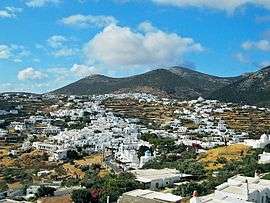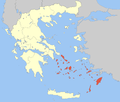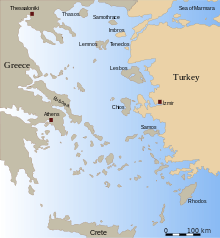Sifnos
| Sifnos Σίφνος | |
|---|---|
|
Villages of Artemonas and Apollonia | |
 Sifnos | |
|
Location within the region  | |
| Coordinates: 36°59′N 24°40′E / 36.983°N 24.667°ECoordinates: 36°59′N 24°40′E / 36.983°N 24.667°E | |
| Country | Greece |
| Administrative region | South Aegean |
| Regional unit | Milos |
| Area | |
| • Municipality | 73.94 km2 (28.55 sq mi) |
| Highest elevation | 679 m (2,228 ft) |
| Lowest elevation | 0 m (0 ft) |
| Population (2011)[1] | |
| • Municipality | 2,625 |
| • Municipality density | 36/km2 (92/sq mi) |
| Time zone | EET (UTC+2) |
| • Summer (DST) | EEST (UTC+3) |
| Postal code | 840 03 |
| Area code(s) | 22840 |
| Vehicle registration | EM |
| Website | www.sifnos.gr |
Sifnos (Greek: Σίφνος; the spelling Siphnos is obsolete in English but still by convention often used to refer to the island in ancient times) is an island municipality in the Cyclades island group in Greece. The main town, near the center, known as Apollonia (pop. 869), is home of the island's folklore museum and library. The town's name is thought to come from an ancient temple of Apollo on the site of the church of Panayia Yeraniofora. The second-largest town is Artemonas (800), thought to be named after an ancient temple of Apollo's sister-goddess Artemis, located at the site of the church of Panayia Kokhi. The village of Kastro (118), was the capital of the island during ancient times until 1836. It is built on top of a high cliff on the island's east shore and today has extensive medieval remains and is the location of the island's archeological museum. The port settlement, on the west coast of the island is known as Kamares (245).[2]
Geography
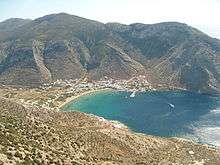
Sifnos lies in the Cyclades between Serifos and Milos, west of Delos and Paros, about 130 km (81 mi) (80 nautical miles) from Piraeus (Athens' port). It has an area of 74 square kilometres (29 sq mi) and is 15 km (9 mi) long and 7.5 km (4.7 mi) wide. and a shoreline of 70 km (43 mi), with a permanent population of 2,625. The island is reached on the ferries which run on the Piraeus- Kythnos- Serifos- Sifnos- Milos- Kimolos line. There are also infrequent sailings to other islands in the Cyclades.
History

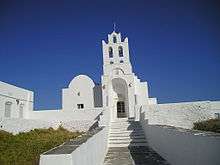
Sifnos was inhabited by human beings from at least 4000 BCE.[3] Archeological evidence indicates the island was within the mainstream of Late Neolithic and Early Bronze Age Cycladic civilization. The island was very wealthy in ancient times, thanks to its gold, silver, and lead, which were being mined there as early as the 3rd millennium BCE.[4] Proof of this is the treasury which the Siphnians built at Delphi in the 6th century BCE to house their offerings. According to Pausanias, these mines were obliterated by floods in ancient times, a disaster which some attributed to the people of the island suspending their tribute out of greed.[5][6] Modern scholars suggest that some of the mines flooded because they had eventually been dug to a depth below sea level,[7] while the majority of them, situated far from the sea, were probably exhausted.[8] Remains of ancient mines, some dating back to prehistoric times, are still to be seen on the island, most notably at Ay. Sostis, and remains of ancient fortifications, dating from the third millennium to the sixth century BCE, have been found at Ay. Andreas, Ay. Nikitas, and Kastro.[9] Another indication of Sifnos's wealth is the fact that it was one of the first places in Greece to mint coins, beginning around 600 BCE, although the number minted does not seem to have been great, and the island of Aegina, which used Siphnian silver, seems to have developed a much greater export capacity in this form of the metal.[10]
During the extensive Greek migrations which occurred beginning perhaps as early as the 12th century BCE, Sifnos was mostly populated by Ionian Greeks from Athens. The island appears only rarely in the subsequent ancient history of Greece. In the sixth century BCE it was invaded by pirates from Samos. In the fifth century BCE, Sifnos was an official member of the Greek defensive alliance formed to fight the Persian Wars. In the next century the island was briefly taken over by the Persians but liberated by a fleet sent by Alexander the Great.[11] The verb "to play the Siphnian"[12] appears in a fragment of Aristophanes, and is explained in the Suda alongside "to Lesbianize" as a reference to transgression.[13][14]
Little is known of Sifnos during the Roman and Byzantine eras, though three Roman sarcophagi remaining in the streets of Kastro and a collection of 80 Byzantine coins in the Museum there testify to substantial continued population during those times. In the early 14th century Sifnos came under the power of the Italian or Spanish Hospitaller Januli I da Corogna, who proclaimed the island independent from the Sanudo dynasty which then ruled most of the Cyclades area. The Corognas ruled Sifnos for over a hundred years; around 1440 as a result of a dynastic marriage power over the island passed to a Bolognese family, the Gozzadini, who ruled until 1617. Though both these dynasties became thoroughly Hellenized, they retained their Roman Catholic form of religion.[15]
Little is also known of Sifnos during the Ottoman rule of the Cyclades from 1537 on. It seems likely that, as in most of the Cyclades, Ottoman rule on Sifnos was fairly loose, consisting mainly of the collection of taxes, with the islanders largely administering their own affairs. By the early 17th century Sifnos was a significant commercial center, and from 1821 the island played an important role in the Greek War of Independence.[16]
Notable figures from Sifnos in modern times include the educator and revolutionary leader Nikolaos Chrysogelos (1780–1858), who served as Greece's Minister of Education, and the chef Nikolaos Tselementes (1878–1958), who wrote a classic cookery book still used in Greece today.[17]
The island's rich clay veins, sunny weather and temperature have made Sifnos a capital of pottery in the Aegean, with unique jars and pots that are a "trademark" of the island. They are typical of the Sifnian everyday life, such as ashtrays, cooking and food vessels, "masteles", "foufoudes" (kind of chimneys) etc. Locally, 'Sifnios' was a variant word for potter. The oldest potteries were found in central regions such as Artemon and Ano Petali to avoid pirate attacks.
Beaches
The most famous ones are:
- Cheronisos (Χερόννησος)
- Poulati (Πουλάτη)
- Faros (Φάρος)
- Platu Gialos (Πλατύς Γιαλός)
- Vathi (Βαθύ)
- Apokofto (Αποκοφτό)
- Broulidia (Βρουλίδια)
- Fukiada (Φυκιάδα)
- Chrysopigi (Χρυσοπηγή)
Churches
There are 360 churches in the island of SIfnos, as per the days of the year. More than any other island in Cyclades. It is no coincidence, the large number of festivals held on the island almost every month. Many churches and monasteries of the island are historical sites with great religious and architectural interest. The most important one is the monastery of Panagia Chryssopigi. One of the most "popular" churches of the island, is one of the Seven Martyrs, where many couples choose to get married . Still, Panagia Poulati renowned both for its beauty and what the landscape that surrounds it.
Religious Festivals (Panigiria)
Sifnos island is very famous for the religious festivals that take place during the summer period. These events is a very good opportunity for a visitor to be familiar with the culture of the island and the famous sifnian traditional cuisine for free. So, do not miss:
In July
- St.Marina in Flabouro in the evening of the 17th
- Prophet Helias (2 events both in the evening of the 19th: on the top of the tallest mountain-also known as Prophet Helias the tall and in Troullaki respectively)
In August
- Holy Virgin (Panagia) on the 15th. There are many events on the following days.
-Panagia tou Nigiou, in the evening of the 16th
-Panagia Platanissa, in the evening of the 16th
-Panagia to Toso Nero, in the evening of the 17th
- St.Symeon in the evening of the 31st
Historical population
| Year | Population |
|---|---|
| 1951 [19] | 2,773 |
| 1981 [20] | 2,856 |
| 2001 [21] | 2,442 |
| 2011 [1] | 2,625 |
Subdivisions
The municipality Sifnos is subdivided into the following districts and villages:
- Apollonia (Apollonia, Vathy, Kamares, Kastro, Kato Petali, Platys Gialos, Faros, Chrysopigi)
- Artemonas (Artemonas, Agia Marina, Troulaki, Cherronisos)
People
- Patriarch Gregory VII of Constantinople
- Patriarch Hierotheus II of Alexandria
- Aristomenis Provelengios, poet and politician
- Nikolaos Tselementes, chef
Gallery
- Artemonas,Madonna of Bali
 Vathi
Vathi The small church of Vathi
The small church of Vathi Kastro
Kastro- Apollonia -steps to the centre
- Apollonia -steps to Ano Petali,Cyclades
 A beach
A beach- Quarry on Sifnos
 Apollonia
Apollonia A church
A church Frieze from the Siphnian Treasury, Delphi
Frieze from the Siphnian Treasury, Delphi
See also
References
- 1 2 "Απογραφή Πληθυσμού - Κατοικιών 2011. ΜΟΝΙΜΟΣ Πληθυσμός" (in Greek). Hellenic Statistical Authority.
- ↑ Barber, Robin, Blue Guide Greece. 6th ed., London, A & C Black, 1995, p. 665
- ↑ Maranti, Anna Siphnos: The Brilliance of Apollo. Athens, Toubis, 2002, p. 18
- ↑ Fitton, J. Lesley, Cycladic Art, London, British Museum, 1989, p. 13, 57.
- ↑ Herodotus III.57
- ↑ Pausanias X.11
- ↑ Bury, J. D. and Meiggs, Russell, A History of Greece to the Death of Alexander the Great. 4th ed., New York, St. Martin's Press, 1978, p. 135
- ↑ Some Aspects of Lead and Silver Mining in the Aegean, VII
- ↑ Barber pp. 665-666.
- ↑ Maranti p. 20.
- ↑ Hammond, N. G. L., A History of Greece to 322 bc, Oxford, Oxford University Press, 1967, pp. 82, 88, 199, 226, 608.
- ↑ Liddell, Henry George; Robert Scott (1940). "A Greek–English Lexicon: σιφνιάζω". Oxford University Press (via Perseus Project). Retrieved 17 July 2012.
- ↑ "Suda On Line: Σιφνιάζειν". The Stoa Consortium. Retrieved 17 July 2012.
- ↑ Henderson, Jeffrey (1975). The Maculate Muse: Obscene Language in Attic Comedy. Yale University Press. p. 213. ISBN 978-0-300-01786-1.
- ↑ Hetherington, Paul, The Greek Islands: Guide to the Byzantine and Medieval Buildings and their Art. London, Quiller, 2001, pp. 301-302
- ↑ Maranti pp. 27-28
- ↑ Maranti p. 34, 42.
- ↑ For more information you can visit Sifnos2day.gr
- ↑ "Detailed census results 1951" (PDF). (Greek) (English)
- ↑ "Detailed census results 1981" (PDF). (Greek) (English)
- ↑ "Detailed census results 2001" (PDF). (39 MB) (Greek) (English)
External links
| Wikimedia Commons has media related to Sifnos. |
 Sifnos travel guide from Wikivoyage
Sifnos travel guide from Wikivoyage- Municipality of Sifnos (in Greek)
